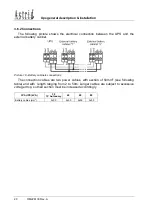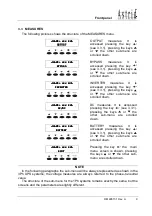
Ups general description & installation
16
OM226130 Rev. A
3.5 BATTERY CONNECTION AND POSITIONING
IMPORTANT
For battery installation please respect the EN62040-1-2 prescriptions, paragraph
4.9.20, and at the same time all the national rules or specifications which can be applied
to the premises or building.
To obtain the battery life indicated by the battery manufacturer, the operating
temperature must remain between 0 and 25 °C. However, although the battery can
operate up to 40 °C, there will be a significant reduction of the battery life.
To avoid the formation of any kind of potentially explosive hydrogen and oxygen
mixture, suitable ventilation must be provided where the battery are installed (see
EN62040-1-2 annex N).
For the materials installed in France, we have to apply the rules according to NFC
15-100 article 554.2: the volume of the renewed air has to be at least 0,005 NI m
3
per
hour, where N is the number of the elements inside the battery and I is maximun current
of the rectifier.
The batteries can be internal or external, however, it is recommended to install them
when the UPS is capable of charging them. Please remember that, if the battery is not
charged for periods over 2-3 months they can be subject to irreparable damage.
In order to avoid any damage during the transport battery is delivered with some
connection cables disconnected (in order to have a battery voltage for each shelve less
than 120V) and with protecteve carboard.
At the time of the installation you will have to provide to remove the protecteve
carboard
(as indicated on label MD388070, placed on the protecteve cardboard)
and to reconnect the cables
(as indicated on label MD388071, placed on the door of
the UPS)
.
IMPORTANT
Only the UPS’s 20KVA and 30kVA (up to 10’ autonomy) 1Ph and 3Ph, have internal
batteries. The bigger sizes must be connected with external battery cabinets.
















































